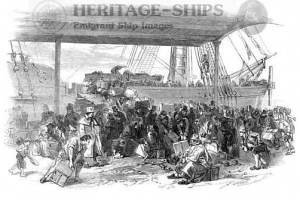Two fascinating accounts of assisted emigration from Ireland have recently been inspected; State Aided Emigration Schemes from the Crown Estates in Ireland and Assistance to Emigrate from the Castlecomer Board of Guardians. The first of these, without provenance, relates to the Castlecomer Poor Law Union (Kilkenny) for the periods 1847-1853. This facsimile of a manuscript is accompanied by the hand written title ‘Guardians; Assistance to Emigrate’. The manuscript is held at the Manuscripts Department of the National Library of Ireland (source: NLI., Ms. 4178). This list appears to have been published in Castlecomer Connections by Tom Lyng, 1984 and is available to search online at Connors Genealogy, although this collection may not be complete.
The manuscript is arranged by year and within each year by name of townland. Under the heading of each townland is the name of the head of family, the number of persons in the family and the cost of their emigration. The manuscript consists of twenty-six pages with some 600 family names. While useful, the manuscript unfortunately does not identify the eventual destination of the emigrants or the names/ages of the individuals within each family group.
A far more comprehensive accounted of assisted emigration from Ireland was published in 1960 in Anelecta Hibernica (22), pp. 329-407, the journal of the Irish Manuscripts Commission. Presented by Eilish Ellis and entitled ‘State-Aided Emigration Schemes from Crown Estates in Ireland ca. 1850’, this is an account of state-aid emigration from five crown estates in Ireland over the periods 1847-52, namely the Crown Estates at Ballykilcline, Co. Roscommon; Irvilloughter & Boughill, Co. Galway; Kingwilliamstown, Co. Cork; Castlemaine, Co. Kerry and Kilconcouse, King’s County. The article is compiled from information contained in the records of the Quit Rent Office, Dublin, which were later transferred to the Public Records Office (now the National Archives of Ireland)
The scheme of assisted emigration from these Crown Estates was carried out under the direction of the Commissioners of Woods, Forests and Land Revenues of the Crown, which was then under the management of the Quit Rent Office in Ireland and was sanctioned by the Colonial Land & Emigration Commissioners. The tenanted Crown Estate lands had by the mid-1830s become over populated and uneconomic. However, the tenants of the lands had refused an offer of assisted emigration in 1836, only to petition the Commissioners for the same assisted emigration in 1847. Between 1847 and 1852 some eleven hundred people emigrated from the five Crown Lands to America and Canada via the assisted emigration Scheme.
The Crown Estate of Ballykilcline is situated in the Parish of Kilglass, Co. Roscommon. Between 19th September 1847 and 25th April 1848, 366 persons emigrated from Ballykilcline via Liverpool for New York on seven different ships at a total cost of £2, 459 14s 3d. Only six families from the Ballykilcline Estate refused assisted emigration from Ireland and these were evicted from their landholdings less than a month after the last group of assisted emigrants departed Ireland.
The article provides details of the circumstances for the assisted emigration from each of the named Crown Lands, which were all eventually sold in the 1850s.
Within each Crown Estate the names of those that took up the offer of assisted emigration are arranged alphabetically within their family groups. Other recorded information for each emigrant includes age and relationship to the head of family; date and port of departure; date and port of arrival; name of ship. Other information where this was forthcoming was recorded: whether the head of the family was an evicted tenant, how many acres were formerly occupied, medical condition, etc.

The majority of the state-aided emigrants from the five Crown Estate sailed for New York between 1847 and 1852. However, some of the emigrants sailed to Quebec from the Irvilloughter & Broughill Estate. The National Archives of Ireland holds the majority of the Quit Rent Office material. The original material consulted by Eilish Ellis is now calendared. Of the twenty of so Crown Estates that survived into the 1850s, the five estates detailed by Ellis would appear to be the only ones from which assisted emigration from Ireland took place.
